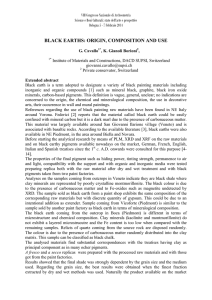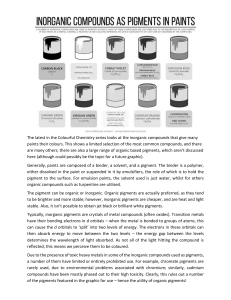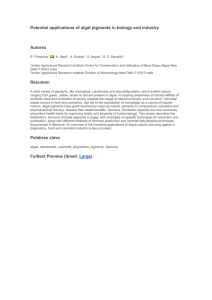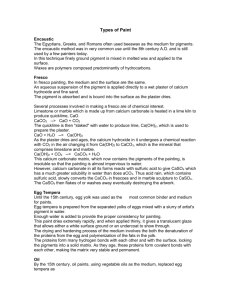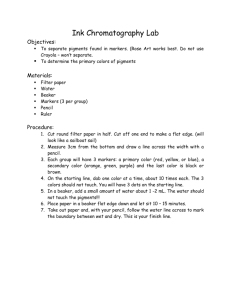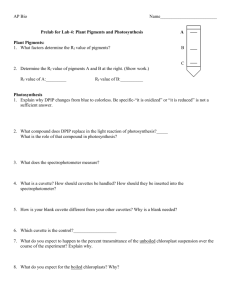PB15 AS 20 AND 21 ARTISTS’ PIGMENTS: CONSERVATION CONCERNS
advertisement
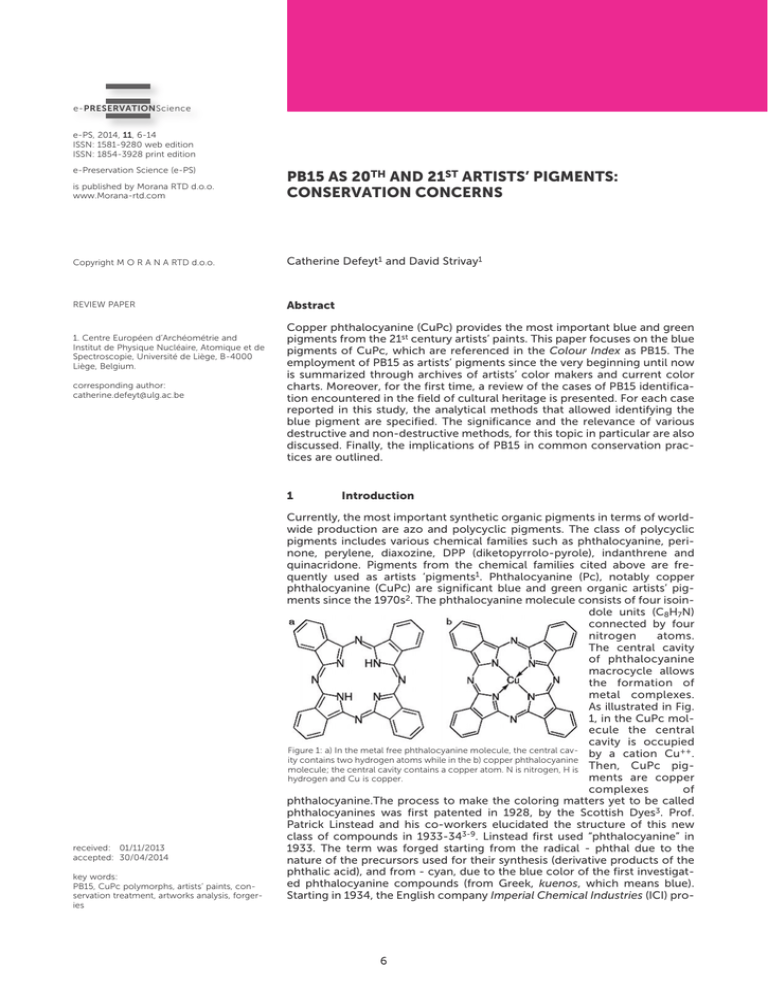
e-PRESERVATIONScience e-PS, 2014, 11, 6-14 ISSN: 1581-9280 web edition ISSN: 1854-3928 print edition e-Preservation Science (e-PS) is published by Morana RTD d.o.o. www.Morana-rtd.com PB15 AS 20TH AND 21ST ARTISTS’ PIGMENTS: CONSERVATION CONCERNS Copyright M O R A N A RTD d.o.o. Catherine Defeyt1 and David Strivay1 REVIEW PAPER Abstract 1. Centre Européen d’Archéométrie and Institut de Physique Nucléaire, Atomique et de Spectroscopie, Université de Liège, B-4000 Liège, Belgium. corresponding author: catherine.defeyt@ulg.ac.be Copper phthalocyanine (CuPc) provides the most important blue and green pigments from the 21st century artists’ paints. This paper focuses on the blue pigments of CuPc, which are referenced in the Colour Index as PB15. The employment of PB15 as artists’ pigments since the very beginning until now is summarized through archives of artists’ color makers and current color charts. Moreover, for the first time, a review of the cases of PB15 identification encountered in the field of cultural heritage is presented. For each case reported in this study, the analytical methods that allowed identifying the blue pigment are specified. The significance and the relevance of various destructive and non-destructive methods, for this topic in particular are also discussed. Finally, the implications of PB15 in common conservation practices are outlined. 1 received: 01/11/2013 accepted: 30/04/2014 key words: PB15, CuPc polymorphs, artists’ paints, conservation treatment, artworks analysis, forgeries Introduction Currently, the most important synthetic organic pigments in terms of worldwide production are azo and polycyclic pigments. The class of polycyclic pigments includes various chemical families such as phthalocyanine, perinone, perylene, diaxozine, DPP (diketopyrrolo-pyrole), indanthrene and quinacridone. Pigments from the chemical families cited above are frequently used as artists ‘pigments1. Phthalocyanine (Pc), notably copper phthalocyanine (CuPc) are significant blue and green organic artists’ pigments since the 1970s2. The phthalocyanine molecule consists of four isoindole units (C8H7N) connected by four nitrogen atoms. The central cavity of phthalocyanine macrocycle allows the formation of metal complexes. As illustrated in Fig. 1, in the CuPc molecule the central cavity is occupied Figure 1: a) In the metal free phthalocyanine molecule, the central cav- by a cation Cu++. ity contains two hydrogen atoms while in the b) copper phthalocyanine molecule; the central cavity contains a copper atom. N is nitrogen, H is Then, CuPc pigments are copper hydrogen and Cu is copper. complexes of phthalocyanine.The process to make the coloring matters yet to be called phthalocyanines was first patented in 1928, by the Scottish Dyes3. Prof. Patrick Linstead and his co-workers elucidated the structure of this new class of compounds in 1933-343-9. Linstead first used “phthalocyanine” in 1933. The term was forged starting from the radical - phthal due to the nature of the precursors used for their synthesis (derivative products of the phthalic acid), and from - cyan, due to the blue color of the first investigated phthalocyanine compounds (from Greek, kuenos, which means blue). Starting in 1934, the English company Imperial Chemical Industries (ICI) pro- 6 © by M O R A N A RTD d.o.o. phthalo blue in 1937, under the name Winsor Blue 23. In France, the Société Lefranc & Bourgeois followed in 1938 by introducing a phthalo blue-based paint, named Hortensia Blue20, in its oil colors range. A similar blue paint from Royal Talens, named Rembrandt Blue, was first mentioned in a product list dating from 194023. Hortensia Blue, Rembrandt Blue and Winsor Blue remain available in current Winsor & Newton, Royal Talens and Lefranc colors ranges. These commercial appellations still indicate paints based on PB15. Despite the early introduction of CuPc in artists’ colors, the mention of phthalocyanine on the paints tubes occurred much later. In Standards of Artists’Oil Paints published in 1960, it can be read24: duced the first CuPc blue pigment, with the molecular formula C32H16N8Cu10. In 1935, Robertson first recognized the polymorphism of the corresponding compound11. Currently, the α-, β- and ε-CuPc polymorphs are industrially produced. The history, synthesis, properties and applications of metallized and unmetallized phthalocyanine compounds are reviewed in detail in Moser and Thomas10, 12, Thomas13, Leznoff and Lever14 and McKeown15, 16. In addition, information focusing specifically on phthalocyanine pigments may be found in general works devoted to synthetic organic pigments, notably in Herbst and Hunger1, Christie17 and Lewis 18. The Colour Index Generic Name of CuPc blue is Pigment Blue 15 (PB15). In fact, PB15 includes six types of CuPc blue, namely, PB15(:0), the unstabilized αform, PB15:1, the non-crystallizing α-form, PB15:2, the non-crystallizing and non-floculating α–form, PB15:3, the β-form, PB15:4, the non-floculating β-form, and PB15:6, the ε-form. The unstabilized α-CuPc blue is often referred to as PB15:0 instead of PB15. The last nomenclature is favored in the present work. Here PB15 is used to indicate the different CuPc polymorphs. The standing committee on Commercial Standards CS98-42, Artists’Oil Paints, met on March 8 of this year for the first time in ten years. Mr Ralph Mayer is the current chairman of the committee, made up of representatives of Grumbacher, Bocour, Permanent Pigments, and other interested parties. At the meeting it was agreed that the chemical name “phthalocyanine” should be placed in parenthesis below any proprietary names that might be used, such as Grumbacher’s Thalo, to indicate the true composition of the pigment. For all of them, the Colour Index Constitution Number is 74160, wherein “74” indicates the phthalocyanine class 19. These pigments differ from each other’s in stability, solubility and hue. For economical reason, PB15:5, which indicates CuPc blue in the g-form, is not produced by manufacturers20. The main processes for making α– β- and ε-CuPc blue pigments which are currently used in industry, are described in Herbst and Hunger 1. Nowadays, instead of chemical names, most of the artists’ colors suppliers use the Colour Index Generic Name to indicate the pigments present in their paints. In 2010, we have investigated thirty-five current ranges of artists’ paints in order to evaluate the importance of PB15 among the 21th century artists’ blue pig- PB15 represents by far the most commercially important phthalocyanine blue pigments. The metal-free phthalocyanine (H2Pc) referenced in the Colour Index as PB16 and the cobalt phthalocyanine (CoPc), referenced as PB75 are much less common. Whereas PB16 is produced since 193921, PB75 was introduced on the market just recently. The CuPc green pigments, PG7 and PG36, are both halogenated copper phthalocyanines derivatives; the green shade is achieved by substituting a certain number of hydrogen atoms by halogens in the CuPc molecule. The halogenated CuPc compounds, do not exhibit polymorphism. PG7 is a copper polychloro phthalocyanine containing 14-15 chlorine atoms, commercially available since 1936. PG36 is a copper polychlorobromo phthalocyanine containing 4-8 bromine atoms and 8-2 chlorine atoms, introduced on the market in 19591. In this paper, only the PB15 types are discussed. 2 Figure 2: Proportions in percentages (%) of the different blue pigments (indicated by their C.I. Generic Name) used in contemporary artists’ oilbased paints. PB15: Copper phthalocyanine (CuPc); PB29: Ultramarine blue; PB27: Prussian blue; PB28: Cobalt blue; PB36: Cobalt turquoise; PB35: Ceruleum blue; PB60: Indanthrone blue; PB16: Metal-free phthalocyanine; PB74: Cobalt zinc silicate blue. Figure taken from Defeyt2 PB15 in modern and contemporar artists’ paints The first CuPc pigment, produced by ICI, was introduced on the market in 1935, under the name Monastral Fast Blue 22. At this time the last blue pigments of importance introduced on the artists’ palette were cobalt blue (first presented by Thénard in 1804) and synthetic Ultramarine blue (first synthesized by Guimet in 1826). The archives of artists’ colors makers, such as product catalogues and color charts, are the earliest sources highlighting the use of CuPc blue in artists’ colors. In England, the artistic material supplier Winsor & Newton first proposed an oil color based on Figure 3: Proportions in percentages (%) of the five types of CuPc blue pigments, indicated by their C.I. Generic Name, used in current artists’ oil-based paints. PB15:0 is the unstabilized a-form, PB15:1 is the noncrystallizing a-form, PB15:3 is the b-form, PB15:4 is the non-flocculating b-form and PB15:6 is the e-form. Figure taken from Defeyt2. naslov, e-PS, 2014, 11, 6-14 7 www.e-PRESERVATIONScience.org Figure 4: Dried paint films obtained from various commercial phthalo blue-based paints on glass slides. Figure taken from Defeyt2. ments2. This survey included several hundreds of blue paints from famous American and European brands, namely Archival oils, Art Spectrum, Blockx, Lefranc & Bourgeois, Graham, Maimeri, M. Harding, Old Holland, Pébéo, Lukas, Sennelier, Schmincke, Royal Talens and Winsor & Newton. The graphic presented in Fig. 1 shows the repartition of the different blue pigments encountered in the survey. The given percentages were calculated on the basis of the suppliers’ declarations. Ultramarine, Prussian blue, cobalt blue and cerulean remain common, but PB15 clearly appears as the most widespread artists’ blue pigment. Examples of dried paint films obtained from commercial phthalo blue-based paints are shown in Fig. 3. Almost half of the investigated blue paints contain a CuPc blue, alone or in combination with zinc white (PW4), titanium white (PW6), Ultramarine blue (PB29) or dioxazine purple (PV23). Actually, in the graphic presented in Fig. 1, PB15 includes PB15:0, PB15:1, PB15:3, PB15:4 and PB15:6. A second graphic showing the distribution of the five CuPc polymorphs is given in Fig. 2. PB15:3 appears as the most important PB15 type. Comparatively, the PB15:6 type is present in much lesser extent. Note that the PB15:2 type, the non-crystallizing and non-flocculating a-form, is absent from the consulted colors ranges. PB75 (CoPc) is also absent from the survey while the presence of PB16 (H2Pc) appears rather marginal compared to the copper complex. 3 from 1936 to 1992 and made by nineteen worldwide famous artists of the 20th century, namely, Schmithals26, Winter27, Penck26, Magritte28, Delvaux29, De Keyser30, Picasso31, Le Corbusier32, Chambers33, Riopelle34, De Saint Phalle 35, Lichtenstein36, Dubuffet, Klein Rancillac37, Pollock38, 39, Judd40, Newman23, 41 and Mondrian42. With the exceptions of the outdoor painted sculpture Three brushstrokes by Lichtenstein, the untitled indoor painted sculpture by Judd and the Untitled mural by Le Corbusier, all the artworks listed in Table 1 are easel paintings. The case of La lampe philosophique painted by Magritte in 1936 points out the fact that the Belgian surrealist introduced the new blue in his palette only one year after its introduction on the market. Magritte was, therefore, one of the earliest painters using PB15. Francis43, Kandinsky44 and Nolan45, also employed PB15 since such pigments have been identified in painting materials from their studio. Information on the concerned materials may be found in Table 1 (section Artists’ materials). Identifying phthalo blue affords chronological information valuable for dating and authenticating artworks. Indeed, when it is detected within original paint layers, the possibility of an artwork made before 1935 may be excluded. To date, at least seven fake paintings, supposedly made between 1896 and 1932, attributed to Popova46, Léger, Ernst, Pechstein47, Utrillo48, Ensor23 and Kandinsky49, were unmasked thanks to the CuPc blue detection. It has also unveiled fake painted papyri presumably dating from 13th -1st BC50. Details on the unmasked forgeries are given in Table 1 (section Forgeries). The α-form, which is the original form, was first commercially available in 193510, while the β- and ε-forms were first patented respectively in 194951 and 196252. Although, the discrimination of CuPc polymorphs could provide supplementary technical and chronological information on the artworks, most often PB15 in artwork analysis: a review of literature Although the Pigment Compendium25 signals only few identifications of CuPc pigments reported in paintings, many cases of artworks containing PB15 are described in conservation literature. As shown in Table 1 (section Works of art), the presence of PB15 has been highlighted, at least in twenty-three works of art, dating naslov, e-PS, 2014, 11, 6-14 8 © by M O R A N A RTD d.o.o. Works of art Artist Title Year Type of PB15 Technique(s) Reference H. Schmithals Gletscherbach 1953-1957 PB15:0 RS 26 F. Winter Federblüten 1958 PB15:1 RS 27 A. R. Penck Young Generation 1975 PB15:4 RS 26 R. Magritte La Lampe philosophique 1936 Unspecified RS 28 P. Delvaux Faubourg 1956 Unspecified RS 29 R. De Keyser Hal (3) 1985 Unspecified RS 30 P. Picasso* Still life with jug Undated Unspecified RS 31 Guitar Undated Unspecified RS 31 Le Corbusier Untitled 1952 Unspecified RS 32 J. Chambers Summer Visitor 1964 Unspecified RS, FTIR 33 J-P Riopelle L’hommage à Rosa 1992 Unspecified FTIR, XRD 34 Hommage à Duchamp 1990 Unspecified FTIR, XRD 34 N. De Saint Phalle Shooting Picture 1961 Unspecified PyGCMS, FTIR 35 R. Lichtenstein Three Brushstrokes 1984 PB15:3 PyGCMS, FTIR 36 J. Dubuffet Mire G131 Kowloon 1983 PB15:3 PyGCMS, FTIR, XRD 37 Y. Klein Monochrome vert 1957 Unspecified PyGCMS, FTIR, XRD 37 B. Rancillac La suite américaine 1970 Unspecified PyGCMS, FTIR, XRD 37 J. Pollock Untitled 1946-49 Unspecified LDI-TOF-MS 38 Mural 1943 Unspecified RIS 39 D. Judd Untitled 1965 Unspecified MALDI-TOF-MS 40 B. Newman Who’s afraid of Red, Yellow and Blue III 1967 Unspecified Micro chemical test 23 Dyonysius 1949 Unspecified XRF, Vis. Reflectance 41 P. Mondrian Composition in Yellow, Blue and White 1937 Unspecified XRF, PCA 42 J. Hayls** A portrait of a Lady and a Boy with a Pan 1655-59 Unspecified EDX, PLM 56 Artist’s studio Painting material Year Type of PB15 Technique(s) Reference S. Francis Studio-made paint (GCI’s ref. SF18) <1994 PB15:1 or PB15:2 RS, FTIR 43 Studio-made paint (GCI’s ref. SF60) <1994 PB15:3 or PB15:4 RS, FTIR 43 Artists’ material Studio-made paint (GCI’s ref. SF42) <1994 Unspecified RS 43 W. Kandinsky Dry pigment (Heliogenblau) ca. 1944 Unspecified - 44 S. Nolan Enemal paint, Ripolin® 1932-1953 Unspecified PyGCMS, FTIR 45 Attribution Title Supposed year Type of PB15 Technique(s) Reference L. Popova Untitled 1900-1935 Unspecified RS 46 F. Léger Cubistic still life 1913 Unspecified XRF, RS 47 M. Ernst La Horde 1927 Unspecified XRF, RS 47 H. M. Pechstein Bridge over the Seine with barge 1908 Unspecified XRF, RS 47 Forgeries Female act lying with cat 1909 Unspecified Micro chemical test, RS 47 M. Utrillo Untitled 1923 Unspecified RS 48 J. Ensor Carnaval 189(6) Unspecified Micro chemical test 23 W. Kandinsky Untitled ca.1932 Unspecified RS 49 Anonymous Painted papyri 13th-1st B.C. Unspecified RS 50 Table 1 Cases of PB15 identification in works of art, painting materials from artists’ studio and forgeries and employed analytical techniques. * Uncertain attribution. ** PB15 has been identified in the overpaint layer. the crystal form of the identified PB15 remains unspecified (see Table 1). (Energy Dispersive X-ray spectroscopy-Scanning Electron Microscopy) and XRF (X-Ray Fluorescence) allow detecting copper in paint layers based on CuPc pigments but are often ineffective to detect the light elements (C, H and N) of the phthalocyanine molecule. CuPc blue pigments contain approximately 10% of copper53. The X-ray spectroscopic techniques, such as PIXE (Particle Induced X-ray Emission), EDX-SEM naslov, e-PS, 2014, 11, 6-14 9 www.e-PRESERVATIONScience.org FTIR is very useful for detecting organic pigments in paint samples. Nevertheless, to ensure the CuPc blue identification, the use of complementary analytical techniques is often required. The efficiency of the FTIR technique strongly depends on the PB15 concentration present in the analyzed paint layer. CuPcs are high tinting pigments used in low proportion by the artists’ color makers1 e.g. 10% is used in the Amsterdam, Rembrandt and Van Gogh oil-based paints from Royal Talens65. As a consequence in the FTIR spectra recorded for paint samples, the intensities of the IR bands induced by PB15 are generally quite weak. Note that the efficiency of FTIR in organic pigments detection may be largely improved by extracting them from paint samples by means of solvent and acid immersions60. The positions of the IR bands arising in the 715-735 cm-1, 765-785 cm-1 and 865-885 cm-1 regions, potentially provide indicators for the α– β- and ε-CuPc polymorph distinction59. Obviously, PB15 cannot be identified on the basis of the copper detection only since many other pigments may contain this metal. In this context, elemental analysis has to be combined with complementary analytical techniques, for instance Raman spectroscopy47, 54. Berns et al.41 identified PB15 in a Newman’s painting by combining XRF and visible reflectance, while Albertson et al.42 identified the pigment in a Mondrian’s painting by performing PCA (Principal Component Analysis) on XRF data. Due to the very small size of the pigment grains (200 nm to 0.5 µm) it is very difficult to identify CuPc by using optical microscopy25, 55. However, the blue pigment has been identified in an over paint from a 17th painting thanks to the combination of EDX and PLM (Polarized Light Microscopy) 56. Apart from the Xray spectroscopies, the detection of the copper contained in the CuPc molecule may be achieved through other techniques such as LIBS (Laser Induced Breakdown Spectroscopy). LIBS provides additional elemental information on the CuPc molecule since it allows the identification of the copper but also the carbon content through the characteristic emission of the CN species of the Pc ring57. In paint samples, however, the CN species could be also assigned to certain binding media such as those based on acrylic resins. For the characterization of PB15 in a commercial artists’ paint sample, Kokkinaki et al.57 completed the elemental analysis data from LIBS with isotopic and molecular mass analysis from LA-TOF-MS (Laser Ablation -Time Of flight- Mass Spectroscopy). Depending on the nature of other components in the paint system, the interpretation of the FTIR results may become very complicated due to the IR band overlapping. In oil-based paints, a strong IR absorption induced by the binder may overlap the strongest PB15 IR band reported at 715-735 cm-1. For acrylic paints, the strong IR band induced by the acrylic resins at ca 750 cm-1 may hide the PB15 IR absorption arising at 750-760 cm-1. In presence of chalk, an overlapping of the filler and PB15 IR bands at 865-885 cm-1 may be also expected66. It can be observed in Table 1 that when the RS technique has not been employed, the PB15 identification was often achieved by using FTIR in combination with Py-GC-MS (Pyrolysis-Gas Ghromatography-Mass Spectrometry) and/or XRD (XRay Diffraction). The Raman and FTIR (Fourier Transform Infra-Red) spectroscopies are both molecular analytical techniques. FTIR and Raman spectra recorded for PB15 specimen are available in the IRUG (Infrared and Raman Users Group) database. XRD is a structural analytical technique efficient for identifying crystalline compounds, such as phthalocyanine pigments. PDFs (Powder Diffraction Files) related to PB15 may be found in the ICDD (International Center for Diffraction Data) database. Sonada et al. 37 pointed out the interest of XRD as a complementary technique for the PB15 identification in the samples taken from paintings by Klein, Dubuffet and Rancillac. More recently, Corbeil et al.34 identified the pigment in two Riopelle’s paintings by using XRD and FTIR. Brostoff et al.67 were not enthusiastic regarding the detection of CuPc pigments in paint samples by means of the XRD method and in Lomax68 the diffraction method led to the PB15 identification in three mock-ups out six. Another study has shown that in the diffractograms obtained for commercial artists’ paints; the number of CuPc diffraction peaks varies from two to ten59. These differences may be explained by the PB15 concentration, the other components present in the paint system and the orientation of the PB15 crystals in the paint film. Obviously, when the number of PB15 diffraction peaks is sufficient, XRD remains the most reliable non-destructive method for discriminating the CuPc polymorphs. Many studies have shown that Raman spectroscopy (RS) was very efficient to detect CuPc blues and greens in paints layers, even in the case of complex mixtures poor in phthalo pigments. In fact, CuPc blue pigments exhibit a typical Raman pattern easily recognizable in spectra recorded on paint samples, irrespective to the PB15 concentration.27,58,59 In Table 1, it may be observed that in many cases of artwork studies, performing Raman analysis only led to the PB15 identification. Note, however, that thermal degradation problems induced by an excessive laser power may arise6062. Through their Raman study of dry pigment samples of PB15, Defeyt et al. 59 have pointed out that Raman band positions in the 1100-1200 cm-1 and 100-150 cm-1 regions and fourteen Raman band intensity ratios vary with the alpha, beta and epsilon CuPc polymorphs. The authors proposed to exploit these differences for discriminating the three crystal forms in paint layers. Unfortunately, in aged paint samples the spectral interpretation is not always straightforward concerning the CuPc polymorph distinction. To overcome the problem a procedure combining RS and LDA (Linear Discriminant Analysis) has been developed63. Until now, this procedure has been applied on more than twenty real paint samples2. Recently, BeaulieuHoule et al.64 reported that pressure-tuning Raman spectroscopy could be helpful for the alpha and beta CuPc distinction. The authors noticed different pressure-induced spectral changes in the 800-900 cm-1 and 1100-1200 cm-1 regions for the alpha and beta polymorphs. For identifying phthalo blue in paint layers, unmixed or mixed with other pigments, several authors have proposed the use of visible reflectance spectrophotometry41, 55, 69. After detecting copper by XRF, Berns et al.41 have identified the CuPc blue and the CuPc green in Dionysius by Barnett Newman thanks to the obtained visible spectral reflectance curves. naslov, e-PS, 2014, 11, 6-14 10 © by M O R A N A RTD d.o.o. In addition, destructive methods, such as Py-GC-MS, LDI-TOF-MS (Laser Desorption Ionization- Time of Flight- Mass Spectroscopy) 38, MALDI-TOF-MS (Matrix assisted Laser Desorption Ionization - Time of Flight40, Mass Spectroscopy) TLC (Thin Layer Chromatography) 70 and DTMS (Direct Temperatureresolved Mass Spectrometry) may be also helpful for identifying PB15 in paint samples 37, 66. The efficiency of micro-chemical test using sulfuric acid described in De Keijzer64 largely depends on the size sample and the PB15 concentration in the mixture72. The actual test has worked for the paint samples taken from a fake painting signed Ensor and another one signed Pechstein. 4 and greens are commonly employed as inpainting materials. The use of modern pigments to retouch paintings made from traditional pigments is sometimes unavoidable, particularly when the pigments used by the artists are toxic, unavailable or prone to a degenerative color change. The imitative retouching is probably the most practiced technique for the inpainting of losses on easel paintings. The degree of the color matching required in the imitative technique may be very difficult to attain, notably in the presence of blue pigments80. Moreover, the attained degree of the color match has to be conserved in all conditions of illumination and observation. The inpainting quality largely depends on the similarity of the spectral reflectance curves between the pigments from the locations adjacent to the paint loss and the retouching pigments and, on the low degree of metamerism of the color match. Berns et al. 81 have defined a retouching palette that contains a reduced number of pigments and that minimizes metamerism. The authors have selected ten pigments having spectral properties that are representative of the very large number of pigments available to the painting conservators. This restricted palette includes copper phthalocyanine blue and green pigment. PB15 is a good candidate for substituting Prussian blue and other blue pigments whose reflectance remains low towards the red region of the visible spectrum81 and could be suitable for matching azurite80. PB15 and conservation treatments Nowadays, conservators have to deal with more and more frequent arrivals of painted works of art containing PB15 in their studio. Most often, the conservation issues posed by modern organic pigments are related to their poor lightfastness and/or their sensitivity to certain solvents. CuPc blue pigments are high performance pigments, they possess a remarkable lightfastness and are insoluble in most of solvents. However, it is of common knowledge that they are partially soluble in aromatic solvents1. According to technical and patent literature, the application of aromatic solvents on a painted surface containing the PB15:0 type involves a risk of color changes, resulting from crystallization defects. The mechanism of crystallization depends on the slight, but still significant solubility of CuPc in aromatic solvents73. This one consists on the transformation of the unstabilized α-form into crystals of the β-form with a strong tendency to grow in size. Crystal growth leads to a reduction of tinctorial strength and to a sliding of the blue hue towards green. Crystallization defects occur especially in presence of toluene (methylbenzene) and xylenes (meta-, ortho and para- isomers of dimethylbenzene) 73-75. Inversely, for matching highly chromatic pigments like CuPc blues and greens, very similar pigments are required81. It is not surprising that Donald Judd complained about the color change of his 1965 Untitled sculpture, repainted in 1976 with a mismatched purple paint. Whereas the original purple shade resulted from the combination of a quinacridone violet (PV19) and a CuPc blue, the PV19 based paint applied in 1976 lacked of PB1540. Furthermore, because the coloristic properties of PB15 strongly depend on the CuPc crystal form, the polymorphic identification could be of great interest for retouching monochromes or pieces with smooth and large surfaces based on PB15, such as those made by S. Francis, B. Newman and R. Lichtenstein. Typical visible reflectance curves obtained for PB15:1, :3, :4 and :6 are illustrated in Perego20. Such solvents are present in various synthetic adhesives, inpainting materials and varnishes employed for conservation treatments of easel paintings76-78. For example, the synthetic varnishes based on Paraloid B72 or Laropal A 81, are prepared by dissolving the resin in toluene and/or xylene. In addition, for oilbased paintings, the use of aromatic solvents remains a possible option for varnish and overpaint removals. A preliminary investigation has shown that cleaning and varnishing tests using aromatic solvents, which have been performed on various PB15:0 based paint films, did not cause crystallization defects, irrespective to the nature of the binding medium2. Nevertheless, the same study has shown how PB15-based paint films, before and after accelerated aging, are highly solvent sensitive and sometimes even water sensitive, irrespective to the CuPc polymorph present in the paint system. Further investigations should be conducted in order to estimate the influence of PB15 on the pH and glass transition (Tg) of such paint films. The range of Gamblin Conservation Colors contains two phthalo blue-based paints; Phthalo Blue is based on PB15:2 (non-crystallizing and non-flocculating αform) whereas Manganese Blue Hue is based on PB15:4 (non-flocculating β-form). For both of them, the concentration of PB15 is 25% 82. In the Kremer Conservation Colors range the phthalo blue-based paints available includes Phthalo Blue that is based on PB15:1 (non-crystallizing α-form) and Phthalo Blue King Blue that is based on PB15:3 (β-form). Primary Blue-Cyan from the Maimeri Restoro range is also based on PB15:3. Commercial inpainting paints based on PB15:0 and PB15:6 are missing. The absence of the PB15:0 type certainly results from its sensitivity to the solvent(s) generally used in such paints. A reddish blue shade similar to PB15:6 may be achieved by combining an α-CuPc pigment with a low proportion of Dioxazine Violet (PV23) 1. The detection of CuPc blue in overpaint layers is relevant for dating previous conservation treatments. For the John Hayls’ painting, A portrait of a Lady and a Boy with a Pan from 1655-59 (Table 1), acquired by the Tate Gallery in 1995, it allowed identifying a 20th overpaint and led to the decision of its removal56. Phthalo blues naslov, e-PS, 2014, 11, 6-14 11 www.e-PRESERVATIONScience.org 5 Conclusions 9. C. E. Dent, R.P. Linstead and A.R. Lowe, Phthalocyanines. Part VI. The structure of the phthalocyanines, J. Chem. Soc., 1934, 1033– 1039. PB15 was incorporated in artists’ paints very soon after the pigment appearance on the market in 1935 and has been adopted by artists since its introduction on their palette. CuPc blue is now the most widespread 21st artists’ blue pigment. Currently, six types of CuPc blue pigments are manufactured. PB15:3 is the type the most used in artists ‘paint formulations. 10. F. H. Moser and A. L. Thomas, Phthalocyanine Compounds, Reinhold, New York, 1963. 11. J. M. Robertson, An X-ray study of the structure of the phthalocyanines. Part I. The metal-free, nickel, copper, and platinum compounds, J. Chem. Soc., 1935, 7, 615–621. 12. L.T.Thomas, Phthalocyanine Research and applications, CRC Press, Boca Raton, FL 1990. Various destructive and non-destructive analytical techniques are suitable for detecting PB15 in paint layers, but the Raman spectroscopy is by the far the most efficient of them. Indeed, CuPc blue pigments exhibit a typical Raman pattern easily distinguishable in spectra recorded on paint samples, irrespective to the PB15 concentration. The distinction of the CuPc polymorphs in paint layers is possible by means of XRD analysis or by combining Raman spectroscopy and LDA. It has been shown that CuPc blue pigments are valuable retouching pigments. On the one hand because they are high performance pigments, on the other hand because they can be used as a substitute of several traditional blue pigments, such as Prussian blue and azurite. Aromatic solvents do not cause the crystallization defects of the PB15:0 pigment crystals, when they are contained in dried paint films. A better knowledge of the factors influencing the sensitivity to solvents of the PB15-based paint films requires further investigations. 13. F.H. Thomas and A.L. Moser, The Phthalocyanines,Volume 1: Properties; Volume 2: Manufacture and Applications, CRC Press, Boca Raton, FL, 1983. 14. C.C. Leznoff and A.P.B. Lever, Phthalocyanines: Properties and Applications, Vols. 1–4, Wiley and Sons, New York, 1996. 15. N. McKeown, Phthalocyanine Materials: Synthesis, Structure and Function, Cambridge University Press, Cambridge and New York, 1998. 16. N. McKeown, Out of the blue: recent advances in the applications of phthalocyanines, Chemistry and Industry, 1999, 3, 92–98. 17. R.M. Christie, Colour chemistry, The Royal Society of Chemistry, Cambridge, 2001. 18. H.M. Smith, Colored organic pigments – overview, in A.P. Lewis, editor, Pigment Handbook, Properties and Economics, Vol. 1, 2nd edition, John Wiley & Sons Inc., New York, 1988, 413–424. 19. Society of Dyers, Colourists, the American Association of Textile Chemists, and Colorists, Colour Index Dyes and Pigments, Bradforf, Yorkshire, 3rd edition, 1971. 20. F. Perego, Dictionnaire des matériaux du peintre, Belin, Paris, 1995. 21. I.M. Heilbron, F. Irving and R.P. Linstead, Coloring matters of phthalocyanine type, Patent US2153620, 11-04-1939. 6 Acknowledgments 22. Blue pigment discovery is the first in 100 years, New York Times, 25-11-1935, p12 This work was supported by the Inter-University Attraction Pole program of the Federal Belgian Science Policy (NACHO P6/16), the University of Liège, and the Institut Interuniversitaire des Sciences Nucléaires. The authors wish to thank the artists’ material suppliers Royal Talens, Jacques Blockx, Kremer Pigmente, Winsor & Newton and Robert Gamblin for their kind collaboration. 7 23. M. De Keijzer, The history of modern synthetic inorganic and organic artists’ pigments discovered in the twentieth century, in : J. A. Mosk, N. H. Tennent, Eds, Contributions to Conservation Research from the ICN, James & James, London, 2002, 42–54. 24. Standards of artists’ oil paints, Bulletin of the American Group, International Institute for Conservation of Historic and Artistic Works, 1960, 1(1), 9–10. 25. N. Eastaugh, V. Walsh, T. Chaplin and R. Siddall, Pigment Compendium: A Dictionary and Optical Microscopy of Historic Pigments, Butterworth-Heinemann, 2008. 26. K. Lutzenberger and H. Stege, From Beckmann to Baselitz Towards and improved micro-identification of organic pigments in paintings of 20th century art, e-Preservation Science, 2009, 6, 89– 100. References 1. W. Herbst, K. Hunger and G. Wilker, Industrial organic pigments: production, properties, applications, Wiley-VCH, Weinheim, 3rd edition, 2004. 27. K. Lutzenberger, Kuntstlerfarben im wandel, Herbert Utz Verlag, Munchen, 2009. 2. C. Defeyt, Copper-phthalocyanine blue pigments in conservation, PhD thesis, Université de Liège, Liège, 2013, http://hdl.handle.net/2268/149555. 28. Personal communication with Prof. Peter Vandenabeele, University of Ghent (UGent), Belgium, 2012. 3. A. G. Dandridge, H. A. E. Drescher and J. Thomas, Improvements in and relating to the manufacture and use of colouring matters, Patent GB322169, 18-11-1929. 29. P. Vandenabeele, A. Hardy, G. M. Edwards and L. Moens, Evaluation of a principal components based searching algorithm for the Raman spectroscopic identification of 20th century artwork, Appl. Spectr., 2001, 55, 525-533. 4. R.P. Linstead, Phthalocyanines. Part I. A new type of synthetic colouring matters, J. Chem. Soc., 1934, 1016–1017. 30. W. Fremout and S. Saverwyns, Identification of synthtic organic pigments: the role of a comprehensive raman spectra Library, in : Book of abstracts, 6th International Congress on the Application of Raman Spectroscopy in Art and Archaeology, Timeo, Bologna, 2011, 33–34. 5. G.T. Byrne, R.P. Linstead and A.R. Lowe, Phthalocyanines. Part II. The preparation of phthalocyanine and some metallic derivatives from ocyanobenzamide and phthalimide, J. Chem. Soc., 1934, 1017–1022. 6. R.P. Linstead and A.R. Lowe, Phthalocyanines. Part III. Preliminary experiments on the preparation of phthalocyanines from phthalonitrile, J. Chem. Soc., 1934, 1022–1027. 31. E. Manzano Moreno, L.R. Rodriguez-Simon, M.R. Lopez-Ramirez and N. Navas Iglesias, Integrated analytical techniques for the study of modern Paintings, in : From Can to Canvas, 25-27 may 2011, CICRP, Marseille, 2011, 72–73. 7. C. E. Dent and R.P. Linstead. Phthalocyanines. Part IV. Copper phthalocyanines, J. Chem. Soc., 1934, 1027–1031. 32. P.-A. Gatier, M.-O. Hubert, B. Gandini and J.-M. Vallet, The paintings of Le corbusier: monumental artworks (1930-1960) in Paris and Cap Martin (France): History, technique and conservation, in : From Can to Canvas, 25-27 mai 2011, CICRP, Marseille, 2011, 44–45. 8. R.P. Linstead and A.R. Lowe, Phthalocyanines. Part V. The molecular weight of magnesium phthalocyanine, J. Chem. Soc., 1934, 1031– 1033. 33. K. Helwig, J. Poulin and M.-E. Thibeault, Mixed media paintings on plywood by jack chambers: application of Fourier Transform Infrared naslov, e-PS, 2014, 11, 6-14 12 © by M O R A N A RTD d.o.o. Aktiengesellschaft Colorants and Finishing Products, Ludwigshafen, 2001. spectroscopy, Raman spectroscopy and Gas Chromatography-Mass Spectrometry (GC-MS), in : 10th Biennal International Conference of the Infrared and Raman Users Group, 28-31 March 2012, University of Barcelona, Barcelona, 2012, 42–43. 54. F. Rosi, C. Miliani, I. Borgia, B. Brunetti, and A. Sgamellotti, Identification of nineteenth century blue and green pigments by in situ X-ray fluorescence and micro-Raman spectroscopy. J. Raman Spectrosc., 2004, 35, 610–615. 34. M.C. Corbeil, K. Helwig and J. Poulin, Jean-Paul Riopelle; the artists’ materials, The Getty Conservation Institute, Los Angeles, 2011. 35. S. De Bernardis, J.H. Townsend, B. Ormsby, T. Green and P. Smithen, Shot and dropped: the conservation of a Niki de Saint Phalle Shooting Picture, in : ICOM 2011 conference, ICOM, Lisbon, 2011. 55. S. Q. Lomax, Phthalocyanine and quinacridone pigments: Their history, properties and use, Rev. in Conserv., 2005, 6, 19–29. 56. H. Brett, The rediscovery of John Hayls’ A portrait of a Lady and a Boy with Pan 1655-9, report, Tate Conservation, London, 2007. 36. R. Rivenc, T. Learner, A. Phenix and J. Wolfe, The identification of paints, in : M. Stefanaggi and R. Hoquette, Eds., Art d’aujourd’hui patrimoine de demain conservation et restauration des œuvres contemporaines, SFIIC, Paris, 2009, 284–291. 57. O. Kokkinaki, C. Mihesan, M. Velegrakis and D. Anglos, Comparative study of laser induced breakdown spectroscopy and mass spectrometry for the analysis of cultural heritage materials, J. Mol. Struct., 2012, 1044, 160-166.58. F. Schulte, K.W. Brzezinka, K. Lutzenberger, H. Stege and U. Panne, Raman spectroscopy of synthetic organic pigments used in 20th century works of art, Journal of Raman Spectroscopy, 2008, 39(10), 1455–1463. 37. N. Sonada, J-P. Rioux and A. R. Duval, Identification des matériaux synthétiques dans les peintures modernes. II. pigments organiques et matière picturale. Stud. Conserv., 1993, 38, 99–127. 38. N. Khandekar, C. Mancusi-Ungaro, H. Cooper, C. Rosenberger, K. Eremin, K. Smith, J. Stenger and D. Kirby, A technical analysis of three paintings attributed to Jackson Pollock, Stud. Conserv., 2010, 55, 204–215. 59. C. Defeyt, P. Vandenabeele, B. Gilbert, J. Van Pevenage, R. Cloots and D. Strivay, Contribution to the identification of -, - and phthalocyanine blue pigments in modern artists’ paints by X-ray powder diffraction, attenuated total reflectance micro-Fourier transform infrared spectroscopy and micro-Raman spectroscopy, Journal of Raman Spectroscopy, 2012, 43, 1772–1780. 39. K. Janssens, G. van der Snickt, M. Alfeld and J. Dik, Macroscopic XRF Imaging of paintings : possibilities, limitations and comparison to other Imaging methods, in : Abstract book of Technart 2013, Amsterdam, 2013. 60. S. Q. Lomax and T. Learner, A review of the classes, structures, and methods of analysis of synthetic organic pigments, Journal of the American Institute for Conservation, 2006, 45(2), 107–125. 40. N. Khandekar, E. Nagy, J. Miller, P. Gottschaller, C. MancusiUngaro, M. Schilling and T. Learner, The re-restoration of Donald Judd’s untitled, 1965, in : Proceedings of The Modern Paints Uncovered Symposium, Tate Modern, London, May 16-19, 2006, The Getty Conservation Institute, Los Angeles, 2008, 157–164. 61. M. Abraham, O. Madden, T. Learner and C. Havlik, Evaluation of the effects of laser irradiation on modern organic pigments, in : K. Dickmann, C. Fotakis and J.F. Asmus, Eds., Lasers in the Conservation of Artworks, vol. 100, Springer Proceedings in Physics, Springer Berlin Heidelberg, 2005, 263–275. 41. R.S. Berns, J. Krueger and M. Swicklik, Multiple pigment selection for inpainting using visible reflectance spectrophotometry, Stud. Conserv., 2002, 47,46–61. 42. C. Albertson, A. Martins, and J. Newhouse, Piet Mondrian in the collection of the museum of modern art - Condition issues, in : Issues in Contemporary Oil Paints, Amersfoort, 28-29 march 2013, Cultural Heritage Agency, Amsterdam, 2013, 74. 62. N. C. Scherrer, Laser dependent shifting of raman bands with phthalocyanine pigments, in in : Book of abstracts, 6th International Congress on the Application of Raman Spectroscopy in Art and Archaeology, Timeo, Bologna, 2011, 203–204. 43. M. Bouchard, R. Rivenc, C. Menke and T. Learner, Micro-FTIR and micro Raman study of paints used by Sam Francis, e-Preservation Science, 2009, 6, 27-37. 63. C. Defeyt, J. Van Pevenage, L. Moens, D. Strivay and P. Vandenabeele, Micro- 44. B. Dagron , Inventaire du matériel de l’atelier du peintre Vassily Kandisky, Techné, 1998, 8, 64–76. Raman spectroscopy and chemometrical analysis for the distinction of Copper phthalocyanine polymorphs in paint layers, Spectrochimica Acta Part A: Molecular and Biomolecular Spectroscopy, 2013, 115, 636–640. 45. P. Dredge, M.R. Schilling, G. Gautier, J Mazurek and T. Learner, Lifting the lid on a collection of Ripolin paint from Sidney Nolan’s studio, in : From Can to Canvas, 25-27 mai 2011, CICRP, Marseille, 2011, 41–42. 64. G. Beaulieu-Houle, D. Gilson and I. Butler, Pressure-tuning microRaman spectra of artists’ pigments: - and -copper phthalocyanine polymorphs, Spectrochimica Acta Part A: Molecular and Biomolecular Spectroscopy, 2014, 117, 61–64. 46. S. Saverwyns, Russian avant-garde... or not. A micro-Raman spectroscopy study of six paintings attributed to Liubov Popova, J. Raman Spectroscopy, 2010, 41(11), 1525–1532. 65. Personal communication with L. Klein Ovnik, engineer at Royal Talens, 29th March 2013. 47. S. Röhrs, A. Schwabe and S. Simon, Forensic investigations of imitated expressionist paintings, in : 10th Biennal International Conference of the Infrared and Raman Users Group, 28-31 March 2012, University of Barcelona, Barcelona, 2012, 190–191. 66. T. Learner, Analysis of modern paints, The Getty Conservation Institute, Los Angeles, 2004. 48. D.L.A de Faria and T.S. Puglieri, A pochoir colored facsimile analyzed by Raman microscopy, in : 10th Biennal International Conference of the Infrared and Raman Users Group, 28-31 March 2012, University of Barcelona, Barcelona, 2012, 140–141. 67. L. B. Brostoff, S. A. Centeno, P. Ropret, P. Bythrow and F. Pottier, Combined X-ray diffraction and Raman identification of synthetic organic pigments in works of art: From powder samples to artists’ paints, Anal. Chem., 2009, 81(15), 6096–6106. 49. S. Saverwyns and W. Fremout, Genuine or fake: a micro-Raman spectroscopy study of an abstract painting attributed to Vasily Kandinsky, in : Art’11, 10th International Conference on Non-destructive investigations and microanalysis for the diagnostics and conservation of cultural and environmental heritage, Florence, Italy, 2011. 68. S.Q. Lomax, The application of X-ray powder diffraction for the analysis of synthetic organic pigments. Part 2: artists’ paints, J. Coat. Technol. Res., 2010, 7(3), 325-330. 69. G. Dupuis, Couleur de la matière picturale : caractérisation des pigments et des mélanges de pigments, effets induits par l’adjonction de liant et de charges, PhD thesis, Université Paris 6, 2004. 50. L. Burgio and R.J.H. Clark, Comparative pigment analysis of six modern egyptian papyri and an authentic one of the 13th century BC by Raman spectroscopy and other techniques, J. Raman Spectroscopy, 2000, 31(5), 395–401. 70. C.H. Fischer, Trace analysis of phthalocyanine pigments by highperformance liquid chromatography, Journal of Chromatography A, 1992, 592, 261-264. 51. R.H. Wiswall, Solvent stable metal phthalocyanine pigments and methods of making the same, US2486351, 25-10-1949. 71. M. De Keijzer, Microchemical analysis on synthetic organic artists’ pigments discovered in the twentieth century, in K. Grimstad, Ed., Preprints of the ICOM Committee for Conservation 9th Triennal Meeting Dresden, ICOM Committee for Conservation, Paris, 1990, 220–225. 52. F.L. Pfeiffer, Pigmentary copper phthalocyanine in the “R” form and its preparation, Patent US3051721, 28-08-1962. 53. BASF, Heliogen - the copper phthalo- cyanine pigments of BASF, BASF 72. M. De Keijzer, Microchemical identification of modern organic pigments in cross-sections of artists’ paintings, in K. Grimstad, Ed., Preprints of the ICOM Committee for Conservation 8th Triennal naslov, e-PS, 2014, 11, 6-14 13 www.e-PRESERVATIONScience.org Meeting Sydney, The Getty Conservation Institute, Los Angeles, 1987, 33–35. 73. F. M. Smith and J. D. Easton, Phthalocyanine pigments-their form and performance, J. Oil Col. Chem. Assoc., 1966, 49, 614-630. 74. J. Julius and N. J. Westfield, Preparation of chlorine-containing copper phthalocyanines, Patent US 2933505, 19-04-1960. 75. E.E. Beard, Stabilized phthalocyanine toners for paints, enamels, and lacquers, Patent US2476951, 26-07-1949. 76. L. Masschelein-Kleiner, Les solvants, IRPA, Bruxelles, 1994. 77. K. Nicolaus, Manuel de restauration des tableaux, Konemann, 1999. 78. C. V. Horie, Materials for conservation, Organic consolidants, adhesives and coatings, Butterworth-Heinemann, Oxford, 2000. 79. P. Smithen, A history of the treatment of acrylic painting, in : T. Learner, P. Smithen, J. Krueger, and M. Schilling, Eds., Modern Paints Uncovered, The Getty Conservation Institute, Los Angeles, 2008, 165– 174. 80. S. Staniforth, Retouching and colour matching: the restorer and metamerism, Stud. Conserv., 1985, 30, 101–111. 81. R.S Berns, M. Mohammadi, M. Nezamabadi, and L.A. Taplin, A retouching that minimises metamerism, in : ICOM 2005 conference, ICOM, 2005. 82. Personal communication with Robert Gamblin, 29th March 2013. naslov, e-PS, 2014, 11, 6-14 14
